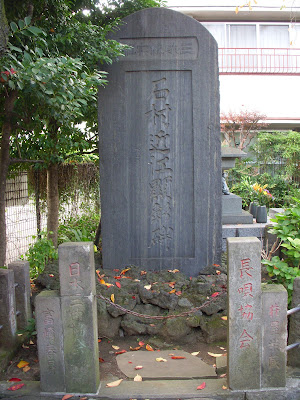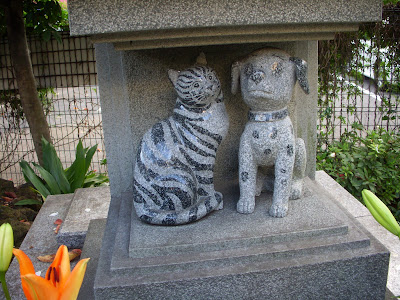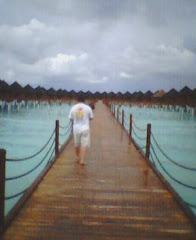After getting my fill of some Japanese history by checking out the graves of the 47 ronin, I decided to roam around the area. The first thing that caught my interest after checking out the temple was the narrow pathway that cuts right between the temple and a high school.
泉岳寺で日本の歴史を探索したあと、その周辺も歩いてみようと思った。最初目に入ったのはお寺と学校の間にある狭い道。どこまで続くのが気になって歩いてみた。
A secret pathway? / 秘密の裏道?
How far does this path go? / 本当に何処まで続くだろう?
It doesn't really lead to anywhere special (unless you're a local I suppose) so I walked back the same way I came and started walking in another direction. That's when I came across an interesting building with a sign that said "Kofuku no Kagaku" which translates to "Science of Happiness". Hm, what the heck is this, I think I need to check it out.
特別な場所に続くわけでもなく(近所の人だったら違うかも知りませんが)、あと戻りして別の方向に散歩再出発。歩く途中に面白い建物を発見。ビルの外側にロマジで“KOFUKU NO KAGAKU”と書いてあった。幸福の科学? なんじゃそれ? 行ってみるしかない。
I still wasn't sure what this place was even after seeing the official sign outside the building which said it was the "Tokyo Shoshinkan".
ビルの正式名を見ても、まだどういう所か分からなかった。東京正心館って何?
Cool building. So I went in. Can you say "Dianetics" and the "Church of Scientology"? Creepy!! I had to get out of there right away, even though I did check out their main altar room? I don't know, I just can't accept this as a church, it just says "cult" all over it. Good thing it wasn't "Aleph", the new name for the "Aum Shinrikyo".
ビルはカッコイイから入りました。これ、アメリカなら“ダイアネティックス”と“チャーチ・オブ・サイエントロジー”思い出すわ!ちょっと気味悪い。メインのホールまで行ってみたが、長時間は居られなかった。なんだか“アレフ” (旧オウム真理教)の匂いがしました!
I also discovered I was walking along a road called the "Isarago Zaka" or "Isarago Slope". One side explains the origin of the name.
歩いてる道が伊皿子坂(いさらござか)と書いてるサインがありました。
横にその名前の由来も書かれてました。
So, the origin of the slope's name is either from some Chinese whose name was Inbeisu or was the mistaken pronunciation of a daibutsu Asaragi. Who knows what the actual origin is?
写真の字読みますか? 「いさらござか 中国人伊皿子(いんべいす)が住んでいたと伝わるが他に大仏(おさらぎ)のなまりともいいさらぶ(意味不明)の変化ともいう。」
This was pretty cool. I came across this in front of a rather small temple. It was named the "Roku Jizo Son" or "Six Jizos". I did further research on the internet and discovered that the "Roku Jizo Son" refers to the "Six Realms of Existence" in Buddhist philosophy. These Jizos protect those who have fallen into the six different realms: 1) Beings in Hell 2) Hungry Ghosts 3) Animals 4) Asura the realm of anger, jealousy, and constant war 5) Humans 6) Deva the realm of heavenly beings Fascinating the things you learn when you walk without a plan.
これも美しいと思った。小さなお寺の前に設置されてる「六地蔵尊」。日本語の説明は下記の写真に書かれてます:
Protects those who have fallen into hell / 地獄道に落ちた人々救って下さる
Protects those who have fallen into the realm of hungry ghosts / 餓鬼道に落ちた人々を救って下さる
Protects those who have fallen into the realm of animals / 畜生道に落ちた人々を救って下さる
Protects those who have fallen into the realm of Asura / 阿修羅道 (あしゅらどう)に落ち争いにあけくれる人々をさとし救って下さる
Protects those in the realm of humans / 人間道に在って悩み苦しむ人々を支え守って下さる
Protects those who have fallen into the realm of heavenly beings / 天上道に在って人々を導き守って下さる
So ends your Buddhism lesson today.
今日の仏教についての事業が終了。
What do we have here? Another historical grave site of someone famous? Who is Oumi Ishimura?
なになに? また有名の人のお墓? 石村近江って誰?どういう人物なの?
Oumi Ishimura was a maker of the shamisen during the Edo Period. The Ishimura family have been making shamisens for 11 generations since the 1600s and they were all named Oumi.
Daishinji Temple where Oumi Ishimura grave is which is located in Minato Ward / 港区にある大信寺 (だいしんじ)、石村近江墓がある場所
Oumi Ishimura's grave / 石村近江墓
I assume this is a grave for pets / 想像でございますが、ペット墓ではないでしょうか?
Next stop, an interesting little museum.
次、小さくてちょっと面白いミュージアム。
Subscribe to:
Post Comments (Atom)





















.jpg)



1 comment:
I would take all six Jizos with me as protection if I had to walk into that Roman-looking building! PS: Narrow alleys are irresistible, aren't they?
Post a Comment